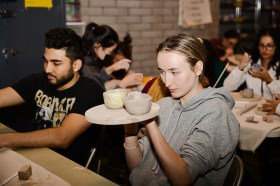Digital tools and software are the bedrock of our lives. Often, the health of our business and passions is directly related to the accessibility and ease of our tools. More broadly, technology has completely changed the durability and impact of artistic practice. Thankfully, a suite of options is available for professional artists and art lovers.
Some sectors of the industry have particular software that has become standard. The Adobe Creative Suite fuels most of the design and publishing sector worldwide. Final Draft is the gold standard in screenwriting. Canva’s free design tools are used ubiquitously across the creative industries. Conversely, there are thousands of apps and tools for visual and digital artists, each offering a different list of advantages and disadvantages.
Below, ArtsHub has gathered some of the other tools available to art lovers and professional artists.
Arts diaries
The New Zealand-developed Letterboxd, a website and app that acts as a social media experience centred on film, has recently experienced a global popularity explosion. Users can share reviews, make lists and upvote particularly witty or insightful comments. Martin Scorsese recently joined the platform.
The Mezzanine Theatre Diary operates in the same manner, except for live performances around the world. It’s currently only available on Apple’s App Store, but it’s already attracted a loyal fan base. It’s making the job of receiving honest audience reviews all the more accessible and has the potential to develop into an excellent resource for performing arts companies.
The Amazon-powered GoodReads has been a leader in the literature sector for years. However, the interface could be improved and hasn’t been updated in years. StoryGraph promises to be a decent competitor, offering a cleaner interface and better integration with book clubs.
Streaming the arts
Streaming theatre productions is no mean feat. Proper payment for technical staff and performers and complicated licensing agreements can make the task impossible for smaller companies. Several services are gaining traction in recent years, particularly prompted by COVID-19.
This includes Australian Theatre Live, which features work from across the country for a small fee every year. Queensland Performing Arts Centre (QPAC) in Brisbane and the Sydney Opera House have launched their own platforms, Digital Stage, while the Australian Theatre For Young People also has ATYP On Demand.
Other international big players include the National Theatre At Home, work from Shakespeare’s Globe in London and New York’s The Lincoln Center. Digital Theatre+ is an education-focused company and Marquee TV focuses on ballet and dance. You can find plenty of blockbusters at BroadwayHD, Dramox and Digital Theatre (a different service to Digital Theatre+, mentioned above).

Apps for running your office and projects
There are many office and project management software options, but not everything is suitable for creative projects. Sharing a central folder on a free Google Drive may suffice for smaller projects. Eventually, upgrading to a Google Workspace for larger teams or projects may be helpful.
Google doesn’t offer a bird’s-eye view of projects and task management that can be useful for productions. Notion is free, shareable and customisable, but will require at least one person on the team to be comfortable setting up pages and projects without pre-existing templates or an intuitive interface. For offices or projects with large teams willing to pay a subscription, Asana, Monday or Slack are all common tools.
Apps for running your studio
Running a studio or training facility can be made a lot easier with the right tool. Smartwaiver and WaiverSign can automate your waiver process. Stripe, Tyro and Square will all help with your payment processing. Reservio and PowerDiary will assist in scheduling your classes and appointments.
Sadly, there is no one-size-fits-all software or app for art businesses and most businesses rely on a specific constellation of tools to fit their purposes. A rare exception is Wellyx, which promotes itself as an all-in-one dance studio platform.
Apps for theatre
Rehearsal Pro has become the go-to resource for digitally inclined actors. Now well over eight years old, the app has had plenty of time to refine itself into a sleek machine. You can highlight lines, record and play them back, have the app loop a scene for drilling lines and much more.
For musical theatre specifically, Show|Ready makes it easy to manipulate music tracks for rehearsal. You can change keys and tempo, add vamps and much more. It’s a robust (and expensive) bit of software and not for the faint of heart. But, if used correctly, it can shortcut a lot of work.
Apps for writers
It’s difficult to believe that 2000 years of storytelling happened without writing software, yet somehow we managed. If you feel you need something beyond a standard office document or a notebook and pen, there’s a suite of options.
For screenwriting, Final Draft remains the industry standard. Beyond this, Scrivener is popular with novelists and other creative writers, allowing you to develop outlines, store notes and see your writing split into specific sections. LivingWriter has made inroads into Scrivener’s audience lately, with its cleaner user interface and AI-integrated auto-suggest feature. Beyond these few, there are hundreds of other options.
ChatGPT and the world of AI
It’s the talk of the planet, but ChatGPT from Open AI has already profoundly impacted the performing arts industries. Some have controversially used the features to design marketing images, while other freelancers use ChatGPT for administrative help.
‘ChatGPT is generic and not the grand solution everyone seems to hype it up to be, but it can be helpful as a tool to help with some of the tedious duties,’ a freelance choreographer tells ArtsHub. ‘I use ChatGPT to draft Risk Assessments or even help me fill out grant applications.’
How AI alters working conditions in the creative industries will continue to evolve in the years to come.





